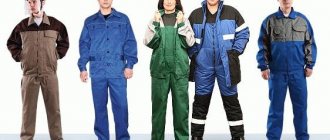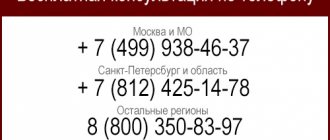Sample job description for a seamstress
General section
- A seamstress is hired and released from work by order of the director of the company, on the recommendation of the head of the sewing workshop.
- The seamstress is directly subordinate to the head of the sewing workshop.
- A person applying for this position must meet certain requirements:
- secondary or secondary specialized education;
- completed professional training course;
- 1 year experience in tailoring.
- During the absence of a seamstress, her duties are performed by another worker of the sewing workshop, appointed by its manager.
- The seamstress is required to know:
- shop labor regulations;
- rules for using appropriate equipment, tools, inventory;
- rules for carrying out sewing events;
- types and characteristics of needles;
- main types of seams;
- rules for working with different types of threads;
- criteria for the quality of work performed;
- the main types of fabrics, leather and other materials used in the sewing process;
- methods for determining defects in manufactured products;
- standards for the consumption of sewing material;
- basic technologies used in clothing production;
- standards for preparatory work with materials;
- rules for cleaning finished products;
- standards for preparing your place for work;
- methods for monitoring the quality of operation of equipment in use;
- fire and technical safety standards, as well as labor discipline.
- The seamstress is guided by:
- relevant laws;
- company documents;
- the contents of this manual.
Functions
A seamstress is expected to perform the following job duties:
- Carrying out tailoring events.
- Monitoring the compliance of the quality of the cut with the required parameters.
- Regulating thread tension and timely replacement of bobbins.
- Applying appropriate sewing techniques for different types of products.
- Preparing material for sewing.
- Cleaning manufactured products from debris.
- Operational control of the correspondence of the color of the material, its type and texture to the manufactured products.
- Monitoring the condition of used equipment.
- Routine maintenance of sewing equipment.
- Ongoing quality control of tailoring and elimination of detected defects in products.
- Elimination of minor problems with machines, tools, equipment.
- Laying sewn products in the prescribed order.
- Filling out the necessary documents.
- Informing the shop manager about problematic issues in work procedures.
- Filling out requests for new materials (needles, threads, etc.) involved in the work process.
- Ensuring cleanliness and order in your workplace.
- Compliance with labor discipline and fire safety standards.
Responsibility
A seamstress can be held accountable in the following situations:
- For damage received by the company through its fault - in the manner determined by the relevant articles of the current legislation and the rules of the company.
- For violations of norms and laws committed in the workplace - in accordance with sections of criminal, civil, administrative law.
- For failure to perform assigned job functions - within the limits given in labor law and company rules.
Rights
At the workplace, a seamstress is entitled to the following rights:
- Make suggestions to improve your work procedures.
- Receive from other employees the information necessary for the work being performed.
- Have access to the criteria by which management evaluates the results of work performed.
- Participate in workshop staff meetings dedicated to current labor issues.
- Require the workshop management to take action to create the conditions necessary for effective work.
https://youtu.be/UKClZ1Q6HgI
Job: Sewing designer
Submit proposals for improvement of work related to the responsibilities provided for in these instructions for consideration by management.
Get acquainted with the draft decisions of the enterprise management concerning its activities. 3.4. Submit proposals for improvement of the organization and methods of work performed by the enterprise management for consideration. 3.5.
The position of production manager is not just a managerial position, but one of the first-level managers.
Using new information technologies, it searches for the most rational solutions for structural and finishing materials and external design details, volumetric and graphic design, detailing product shapes, develops layout and composition solutions, and prepares data for calculating the economic justification of the proposed design.
Creating a job description
Current laws, like administrative regulations, do not prescribe the parameters of job descriptions. As a result, in business practice standard instructions are used, which are modified by enterprises to suit their needs. Such documents must comply with certain design parameters. According to these parameters, their structure consists of four sections:
- Main part.
- Job responsibilities.
- Responsibility of the employee for violations.
- Employee rights.
Large enterprises seeking to formalize their relationships with employees prefer an extended form of instructions. To do this, they add some of the following sections to it:
- Working conditions.
- Parameters for assessing achieved results.
- Official connections.
- Candidate level requirements.
Including additional sections makes sense if you have to deal with numerous specialists in different positions. Then detailed instructions can save time for managers and employees, relieving them of unnecessary individual proceedings.
From a design point of view, the instructions must contain the main attributes of a business document. Therefore, it is printed on company letterhead, which contains the company’s details, date of compilation, transcript of signatures, etc.
Attention! A suitable professional standard can be used as a guide for the job description, which thoroughly lists the job functions and the skills required for them. For the seamstress profession, the closest professional standard is 33.016, approved by the Ministry of Labor on December 24, 2015.
a common part
An introductory section used to prescribe the basic parameters of an employee’s activities. It provides the following information:
- Who should replace an employee during his absence due to vacation, illness, etc.
- What should an employee focus on at work?
- What are the expected skills, work experience and level of education?
- Who is he subordinate to?
- Which manager is responsible for hiring and firing him.
Attention! For a seamstress, job functions can vary greatly in different areas of work. Sewing leather or fur products, making covers, etc. — they all require different skills. Specific skill requirements must be displayed in this section.
Functions
The key part of the instructions, which provides an exhaustive list of the employee’s job responsibilities. If the basic functions are more or less the same at different enterprises, then the list of secondary ones greatly depends on the industry characteristics of the employer, its size, management structure and other factors.
Traditionally, the section separately includes the obligations to comply with labor safety rules, maintain order at the place of work, etc.
Attention! The listed job functions must correspond to the skills indicated in the previous section. The skills and abilities expected from the candidate must ensure high-quality performance of the required work.
Responsibility
This part of the document is based on current legislation, which prescribes penalties for offenses committed. Therefore, in this section it is enough to mention in a general format several types of liability for the most common offenses.
Rights
Article 21 of the Labor Code already contains a list of the basic rights of an employee, and this section contains additional opportunities for a specialist provided to him by the employer. This list depends on the labor policy of the employing company, the employee’s place in its hierarchy, the scope of his responsibilities and other points.
The process of writing instructions takes several stages:
- Creation of an initial version based on suitable specialized professional standards and standard instructions.
- Discussion of the resulting document with a lawyer, HR manager, and specialists in the field where the employee will work.
- Submitting the revised version for approval to the director.
- Familiarization with the document of the candidate for the position during his employment.
- Applying signatures according to the norms of document flow in force in the company.
Attention! The employee has the right to request a separate copy of the instructions from the HR department. It can be provided in paper form or as an electronic file on a local network. In the latter option, you must first remove personal information from it.
The sample must follow the instructions of the sewing cutter
Carries out the selection and analysis of patent and other scientific and technical information necessary at various stages (stages) of artistic design.
Responsibilities: ~Control over the entire technological process (from patterns and cutting to the final product). ~ Development and execution of documentation for product launches ~ Completing comments on samples ~ Prompt resolution of current issues ~ Monitoring deadlines…
The rights, functions and responsibilities of such a specialist are established in the job description of a technologist. The more detailed this document is, the fewer problems there will be in the relationship between the employee and the employer.
PC knowledge (required), creative approach, desire to develop, ability to work in a team and with customers. Full social package.
This job description defines the functional duties, rights and responsibilities of the technologist [Name of the organization in the genitive case] (hereinafter referred to as the Company).
Therefore, a consumer service enterprise must be rationally planned, and also comply as much as possible with intratechnological production processes.
Making changes to technical documentation in connection with adjustments to technological processes and production modes in all departments.
Currently, the development of clothing enterprises, both light industry and the consumer services sector, is carried out in a market economy, the search for the most flexible production and organizational structures, the establishment of partnerships and the competitiveness of enterprises.
In addition to full-time staff, it is also possible to use accountant services for outsourcing or remote work.
A person with specialized secondary education and work experience as a fashion designer of at least 3 years is appointed to the position of category II fashion designer.
Job responsibilities of a seamstress without category
The job description of a seamstress does not require obtaining a category to perform the following types of work:
- Labeling of textile products.
- Measuring and subsequent cutting of fabrics for further sewing of products.
- Design and manufacture of parts for specific purposes.
- Sewing products from natural and artificial leather.
- Textile repair using heat treatment.
- Repair of canvas products (for example, tents) and other products that require knowledge of the location of eyes, loops, bushings, edgings and ropes and the use of techniques not directly related to sewing.
To be allowed to perform other work in the seamstress workshop, a specialist must obtain the appropriate rank. The division is based on the degree of complexity of a particular sewing method, accuracy, and speed of work execution.
What kind of profession is this?
A professional seamstress today performs operations both by machine and by hand. The simplest ones are sewing, adjusting clothes to fit. Sometimes minor repairs to textiles. As a rule, such works, despite their simplicity, are very popular.
Specialists work both in large textile productions and in small studios. Many people open their own workshops.
What else makes the seamstress profession stand out? Mastering the skill is easy: to work in an atelier, it is enough to complete specialized courses. For further professional development, it is necessary to acquire more and more new categories of seamstresses. The higher the category, the more serious the work, the higher the wages and the demand for specialists.










